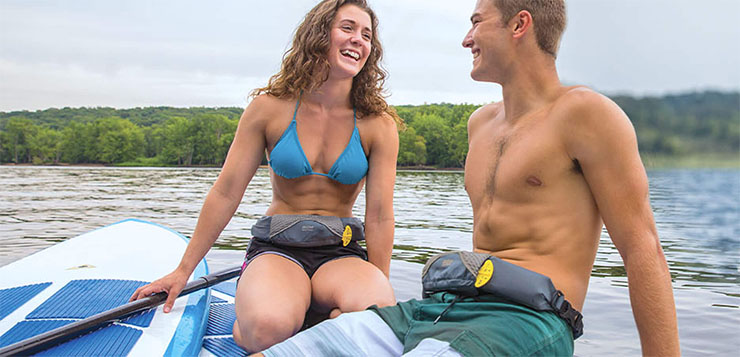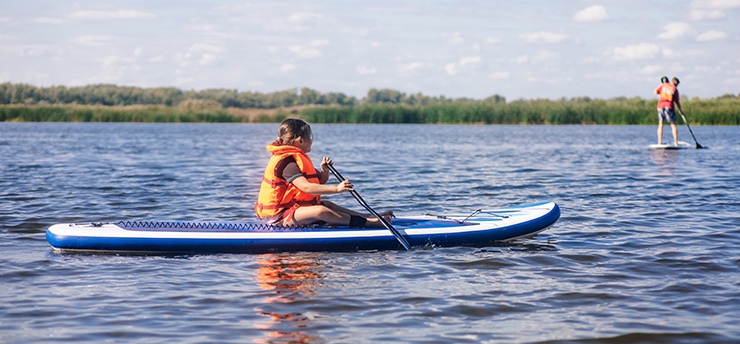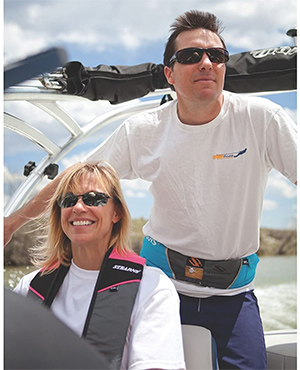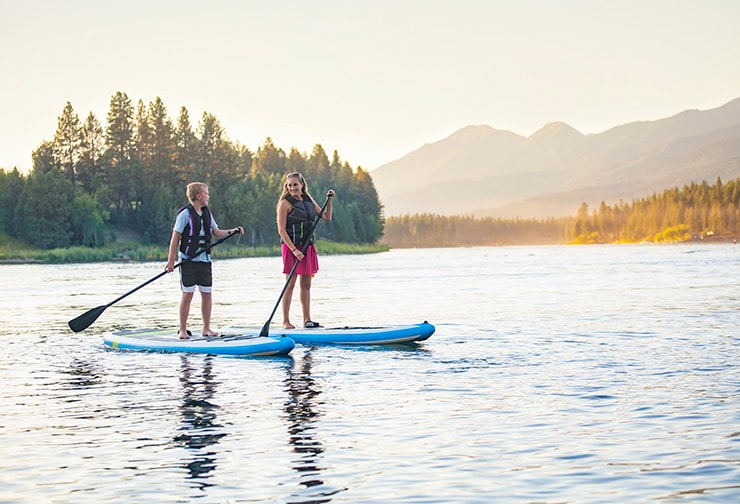Safety is Important to consider whenever you go out on the water, and paddle boarding is no exception. Whether you’re a beginner, intermediate, or a skilled expert, it’s important to always wear an appropriately sized life jacket whenever you go out on your board.
If you SUP regularly, you’ve likely wondered if you’re legally required to wear a life jacket while paddle boarding. You’ve probably also wondered about PFD regulations, and what exactly you need to look for in a life jacket for paddle boarding – as opposed to other types of water sports (and if there is, indeed, a difference).
Let’s take a look at the answers to these questions.
Wearing a PFD is Recommended When Paddle Boarding
Any time you are out on the water, there’s a risk that something can go wrong and compromise your safety. One of the first lines of defense in staying safe is having a life jacket on.
Wearing a PFD is not only recommended, it is sometimes actually required (depending on the type of water you are paddling).
When you wear a properly fitted life jacket, you decrease your chances of preventable drowning and injury. Even the most experienced water lovers can fall victim to a preventable injury. With the right life jacket on, you can stay safe all while having fun.

Understanding Paddle Board Life Jacket Requirements
As the popularity of stand up paddle boarding continues to grow, federal, state, and local laws have adapted and continue to change in order to enhance the safety of paddle boarders while they are on the water.
While there is no blanket federal law mandating that adults must wear life jackets when they are paddle boarding, the United States Coast Guard does have some guidelines in place when it comes to specific bodies of water.
Paddle boards are classified as “vessels” by the USCG. As part of this classification, the USCG states that if paddle boarders are on a SUP in a surfing, swimming, or bathing area, then paddlers must wear a life jacket and adhere to current life jacket regulations.
Lifejacket requirements for paddle boarders include the following:
- Paddlers age 13 and over must have a USCG approved type I, II, III, or appropriately sized type V life jacket. Paddlers age 13 and over are not required to wear the life jacket but they must have it on board. However, the USCG highly recommends that paddlers wear their life jackets every time they go out on the water.
- Children age 12 and under must wear their USCG-approved life jackets whenever they are on the water.
- Life jackets must be in “serviceable condition.” This means that the life jacket is free of any rips or tears or obvious signs of deterioration that could impact the life jacket’s performance
- Type V life jackets may only be used as long as appropriate for the activity at hand.
- Paddlers can opt for a belt pouch type inflatable PFD to serve as a life jacket. In order to meet the life jacket requirements, this belt pouch inflatable must be worn at all times.
- Life jackets must always be the appropriate size and fit for the wearer. Using an i-ll fitting or incorrectly sized jacket can be just as unsafe as not using a life jacket at all.
Paddle Boarding With Children? They Need a Life Jacket Too
Under U.S. federal law, children under the age of 13 must always wear a life jacket when they are on a vessel. Because paddle boards fall under the category of “vessel”, the same rule applies to children under 13 who are on paddle boards.
It’s not uncommon for families with young children to take their kids out paddle boarding with them. Parents and older adults who do this will usually seat their child in front of them in the middle of the deck. If you bring along a child with you on your paddle boarding adventure, it’s important that your child follows USCG life jacket requirements as well.
As with adults, it’s even more important that young children wear a properly fitted and sized life jacket or vest. Type I and Type II are usually recommended for infants and toddlers. These jackets provide neck support that can help a child remain face up when they are in the water.

What type of life jacket do you need for paddle boarding?
The USCG offers clear guidelines on the different types of life jackets available and what those life jackets are best used for.
There are five different classifications for life jackets. Let’s go over these classifications, who they’re best suited for, and why you might choose one type of floatation aid over another.
Type I
Type I life jackets are often regarded as the safest as they offer the most highest buoyancy rating, roughly 20 pounds. These are the bulkiest type of life jackets, because they are designed for offshore use.
They will often feature a classic orange hue with reflective strips for added visibility. Type I jackets also offer neck support which allows them to turn an unconscious user face up.
Type II
Type II jackets are very similar to type I as they also feature neck support to aid unconscious swimmers. However, they offer a little less buoyancy, roughly 15 pounds.
These types of jackets are often used for nearshore boating activities and are suitable for young paddlers. Because they are bulky, they might not be the best option for adult paddle boarders.
Type III
Type III life jackets are the more popular type of personal flotation devices because of their form fitting style. A Type III PFD will zip or buckle up at the front and is generally more comfortable than a Type I or Type II jacket. They offer about 15.5 pounds of buoyancy and are great options for paddle boarders who want safety and comfort.
Type IV
Unlike the other classification of life jackets, Type IV PFDs are inflatable units that are designed to be held onto. These PFDs often resemble square or circular seat cushions. They do not help individuals who are unconscious because you have to hold on to them in order to float.
These types of PFDs are often recommended to be used alongside life jackets, however, they can be used standalone in emergency situations.
Type V
The final classification, Type V PFDs are what are known as special use PFDs. These specialty use devices can include inflatable life jackets, pouch life jackets, or some other combination of a flotation device. Special to use PFDs are designed for a specific type of activity and should be used according to that activity.
Look For a USCG Approved Life Jacket
When you are shopping for the best life jacket for your paddle board adventures, you always want to make sure that your PFD is USCG approved.
USCG approval takes into consideration several factors including the integrity of a jacket, the material it’s made out of, and its sizing. As with all safety equipment, looking for that USCG approval gives you the peace of mind that it’s a dependable life jacket.
Consider the Type of Paddling You’ll Be Doing
The type of paddle boarding you do will also dictate the type of life vest you should wear. For example, if you are going to take your stand up paddle board out on rough waters, then you may want to wear a type II or type III vest. This will keep you protected in those rough conditions while staying comfortable.
On the other hand, if you’re doing some light touring or even SUP yoga, then a Type II or III wouldn’t be the best choice. Instead, you may want to bring along a specialty using PFD that won’t get in the way as you move around.
Shopping for Comfort

Comfort is an important factor to keep in mind when you’re looking for the best personal flotation device for your needs. Comfort is important because if you’re not comfortable as you’re paddling, and your vest gets in the way, you’re not going to enjoy your paddle boarding as much.
You want to opt for a vest with optimal comfort that doesn’t restric movement. A general rule to consider is the more extreme your paddle boarding adventure will be, the more durable your life jacket should be.
For example, there’s no need to wear a type I or type II life jacket if you’re only going to do something like light touring. However, if you plan on going out on the ocean or catching some rapids, then there might be a need for a type II or type II life vest.
Does Price Point Matter?
Price point should not play a huge role when you shop around for a life jacket, but it’s a factor to consider. The price of a personal flotation device does not dictate how well that PFD will perform. On the other hand, however, you don’t want to buy the cheapest PFD out there either.
When considering the price, keep in mind whether the jacket is USCG approved, whether it’s a good fit for your body type and whether it’s appropriate for the activity at hand. Once you have a range of life jackets that fit these criteria, then you should consider the price. This will allow you to shop according to a budget that works for you.
Using an Inflatable Belt Pack on Calm Conditions
A popular option for paddle boarding is using an inflatable belt pack. Inflatable belt packs are pouch styled PFDs that go around your waist. When you hit the water, these PFDs will inflate manually or automatically depending on the type you have.
For many paddlers, especially those who are doing some light touring on calm waters or are practicing SUP yoga, belt packs are a great option. These types of PFDs do not get in your way as you paddle. They’re rather lightweight, and they are super comfortable to wear.
The main factor to keep in mind with these types of inflatables is maintenance and care. You’ll need to do regular inspections on the types of inflatables and they require more upkeep than traditional life jackets.
It’s also important to read and understand the manufacturer’s warranty carefully as well.
Conclusion
No matter the type of water activity you engage in, and no matter the skill level you have when it comes to swimming, it’s critical to practice proper safety. The easiest way to stay safe while out on the water is by wearing a life jacket that fits properly and is USCG approved. With the many options available for you to choose from, there’s a life jacket out there for every type of paddler.

